
|
|
Font Size:
|
||||
|
|
|
|
||||
STATISTICAL BRIEF #275:
Trends in Antipsychotics Purchases and Expenses for the U.S. Civilian Noninstitutionalized Population, 1997 and 2007
Highlights
- From 1997 to 2007, total expenses for prescription antipsychotics in an outpatient setting increased more than three-fold, rising from $1.7 billion to $7.4 billion.
- The average annual expense for antipsychotic medications for persons with one or more prescription antipsychotic purchases increased nearly 1.5 times, rising from $765 to $1,905, when comparing 1997 to 2007.
- When comparing 1997 and 2007, the total number of prescription purchases of antipsychotics increased from 17.4 million in 1997 to 32.4 million in 2007.
- When comparing 1997 and 2007, the average total expense per antipsychotic prescription purchase increased from $96 to $228.
Introduction
This Statistical Brief examines trends in purchases and expenses for outpatient antipsychotics from 1997 to 2007. The estimates included in this Brief are derived from 1997 and 2007 data for the U.S. civilian noninstitutionalized population from the Household Component of the Medical Expenditure Panel Survey (MEPS-HC). For antipsychotics, the Brief compares 1997 and 2007 total expenses, purchases, and persons purchasing, as well as the average total, out of pocket, and third party expenditure per person and per purchase. For this Brief, the Multum Lexicon therapeutic classification system produced by Cerner Multum was used to determine the drugs included in the antipsychotics therapeutic subclass.
Antipsychotics are used to treat schizophrenia and schizophrenia related conditions. Conventional "typical" antipsychotics have been available since the mid-1950s. In the 1990s, new antipsychotic medications were developed. These new medications are referred to as second generation or "atypical" antipsychotics.1
Only prescribed medicine purchases in an outpatient setting are included in the estimates presented in this Brief. Prescription medicines administered in an inpatient setting or in a clinic or physician's office are excluded from the estimates in this Brief. Expenses are in real dollars; estimates for 1997 were adjusted to 2007 dollars based on the Gross Domestic Product (GDP) Price Index (http://www.meps.ahrq.gov/mepsweb/about_meps/Price_Index.shtml). All differences discussed in the text are statistically significant at the 0.05 level.
Findings
When comparing 1997 and 2007, MEPS estimates show an increase of over 300 percent, from $1.7 billion in 1997 to $7.4 billion in 2007, in total outpatient prescription expenses for antipsychotics (figure 1).
The total number of prescribed medicine purchases of antipsychotics increased approximately 86 percent from 1997 to 2007, rising from 17.4 million purchases to 32.4 million purchases (figure 2).
The total number of people, as well as the proportion of the population, purchasing antipsychotics increased between 1997 and 2007, rising from 2.2 million people (0.8 percent) to 3.9 million people (1.3 percent) (figure 3).
When comparing 1997 and 2007, the average annual expense per person for those buying one or more antipsychotic medications increased nearly 150 percent, rising from $765 to $1,905. Moreover, the average third party annual expense per person increased from $599 to $1,695, an increase of more than 180 percent. The average per person out of pocket expense did not increase significantly (figure 4).
When comparing 1997 and 2007, the average annual expense per antipsychotic drug purchase increased about 138 percent, rising from $96 to $228. In addition, although the average out of pocket expense did not change significantly, the average third party expense increased from $75 to $203, an increase of 171 percent (figure 5).
Data Source
The estimates shown in this Statistical Brief are based on data from MEPS HC-068: Multum Lexicon Addendum Files, MEPS HC-020: 1997 Full Year Consolidated Data File, MEPS HC-016A: 1997 Prescribed Medicines File, MEPS HC-113: 2007 Full Year Consolidated Data File, and MEPS HC-110A: 2007 Prescribed Medicines File.
Definitions/Methodology
Purchases and expenses
Purchases were defined as antipsychotic drugs prescribed and purchased in the year of interest. Refills as well as original prescriptions are included in expense and purchase estimates. Individuals were classified as purchasing a prescribed antipsychotic drug if they reported one or more such purchases during the year of interest. Expenditures include the total direct payments from all sources to pharmacies for prescriptions reported by respondents in the MEPS-HC. Expenditures are in real dollars; estimates for 1997 were adjusted to 2007 dollars based on the GDP Price Index (http://www.meps.ahrq.gov/mepsweb/about_meps/Price_Index.shtml).
Therapeutic classifications
Therapeutic class and subclass were assigned to MEPS prescribed medicines using Multum Lexicon variables from Cerner Multum, Inc. MEPS prescribed medicines files were linked to the Multum Lexicon database to obtain therapeutic class and subclass variables. For both 1997 and 2007 data, the antipsychotics therapeutic subclass was included in the psychotherapeutic agents therapeutic class of drugs. Also, in both 1997 and 2007, the antipsychotics therapeutic subclass included the following therapeutic sub subclasses: miscellaneous antipsychotic agents, psychotherapeutic combination, phenothiazine antipsychotics, and thioxanthenes. However, the therapeutic sub subclass of atypical antipsychotics was only included in the 2007 Multum therapeutic classification scheme. (Atypical antipsychotics were first introduced in the 1990s.) For additional information on these and other Multum Lexicon variables, as well as the Multum Lexicon database itself, please refer to Multum's Web site.
Sources of payment
- Out of pocket: This category includes payments by the person or other family members.
- Third party payer: This category includes payments by Medicare, Medicaid, private insurance, Veterans Affairs, CHAMPVA, TRICARE, Other Federal Sources, Other State and Local Sources, Workers Compensation, and Other Unclassified Sources.
About MEPS-HC
MEPS-HC is a nationally representative longitudinal survey that collects detailed information on health care utilization and expenditures, health insurance, and health status, as well as a wide variety of social, demographic, and economic characteristics for the U.S. civilian noninstitutionalized population. It is cosponsored by the Agency for Healthcare Research and Quality and the National Center for Health Statistics.
For more information about MEPS, call the MEPS information coordinator at AHRQ (301) 427-1656 or visit the MEPS Web site at http://www.meps.ahrq.gov/.
References
For a detailed description of the MEPS-HC survey design, sample design, and methods used to minimize sources of nonsampling error, see the following publications:
Cohen, J. Design and Methods of the Medical Expenditure Panel Survey Household Component. MEPS Methodology Report No. 1. AHCPR Pub. No. 97-0026. Rockville, MD. Agency for Health Care Policy and Research, 1997. http://www.meps.ahrq.gov/mepsweb/data_files/publications/mr1/mr1.shtml
Cohen, S. Sample Design of the 1996 Medical Expenditure Panel Survey Household Component. MEPS Methodology Report No. 2. AHCPR Pub. No. 97-0027. Rockville, MD. Agency for Health Care Policy and Research, 1997. http://www.meps.ahrq.gov/mepsweb/data_files/publications/mr2/mr2.shtml
Cohen, S. Design Strategies and Innovations in the Medical Expenditure Panel Survey. Medical Care, July 2003: 41(7) Supplement: III-5-III-12.
Ezzati-Rice, TM, Rohde, F, Greenblatt, J, Sample Design of the Medical Expenditure Panel Survey Household Component, 1998-2007. Methodology Report No. 22. March 2008. Agency for Healthcare Research and Quality, Rockville, MD. http://www.meps.ahrq.gov/mepsweb/data_files/publications/mr22/mr22.shtml
Suggested Citation
Stagnitti, M. N. Trends in Antipsychotics Purchases and Expenses for the U.S. Civilian Noninstitutionalized Population, 1997 and 2007. Statistical Brief #275. January 2010. Agency for Healthcare Research and Quality, Rockville, MD. http://www.meps.ahrq.gov/mepsweb/data_files/publications/st275/stat275.shtml
AHRQ welcomes questions and comments from readers of this publication who are interested in obtaining more information about access, cost, use, financing, and quality of health care in the United States. We also invite you to tell us how you are using this Statistical Brief and other MEPS data and tools and to share suggestions on how MEPS products might be enhanced to further meet your needs. Please e-mail us at mepspd@ahrq.gov or send a letter to the address below:
Steven B. Cohen, PhD, Director
Center for Financing, Access, and Cost Trends
Agency for Healthcare Research and Quality
540 Gaither Road
Rockville, MD 20850
Footnotes
1 National Institute of Mental Health. Mental Health Medications. NIH Publication No. 08-3929. Bethesda, MD: National Institute of Health, 2008.
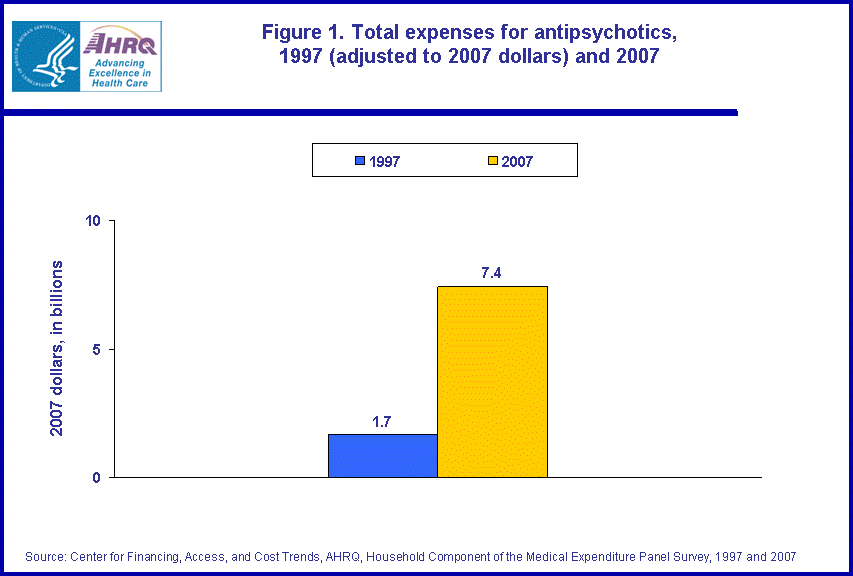 |
||||||||||||||||||||||||
|
||||||||||||||||||||||||
|
|
||||||||||||||||||||||||
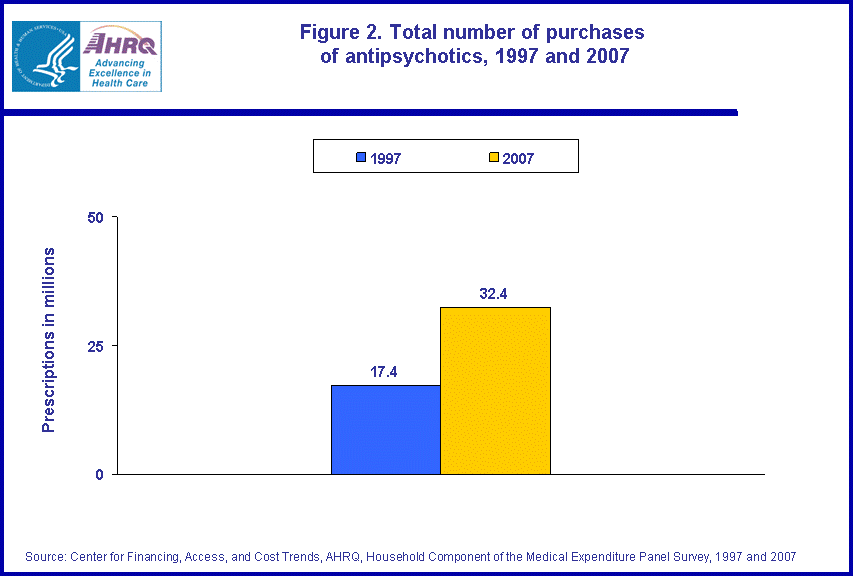 |
||||||||||||||||||||||||
|
||||||||||||||||||||||||
|
|
||||||||||||||||||||||||
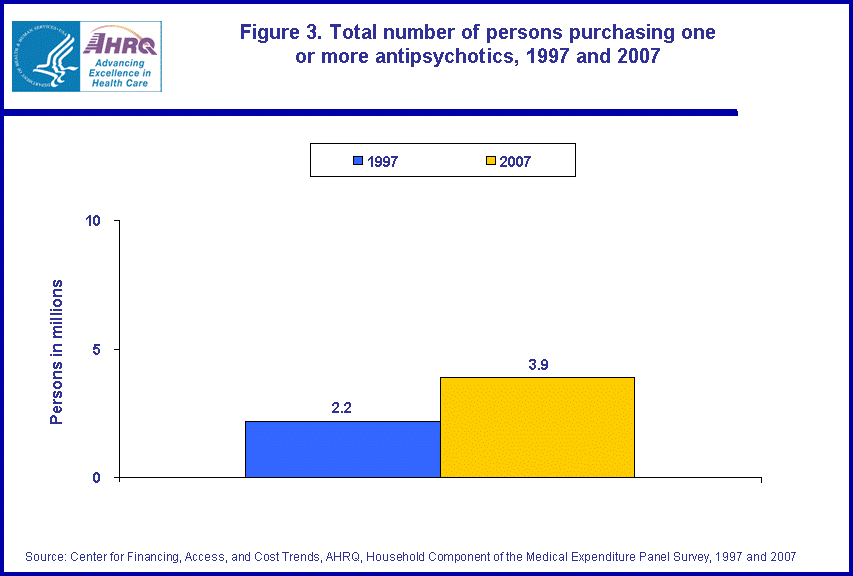 |
||||||||||||||||||||||||
|
||||||||||||||||||||||||
|
|
||||||||||||||||||||||||
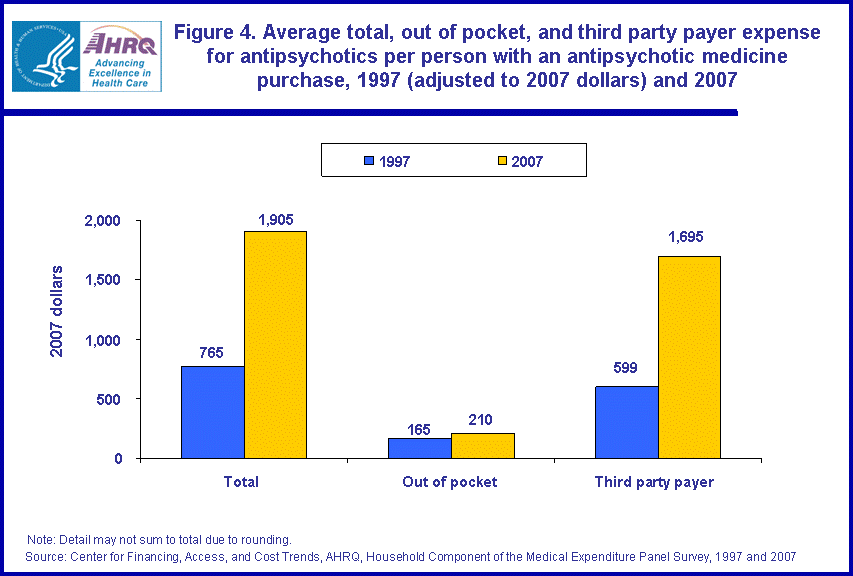 |
||||||||||||||||||||||||
|
||||||||||||||||||||||||
|
|
||||||||||||||||||||||||
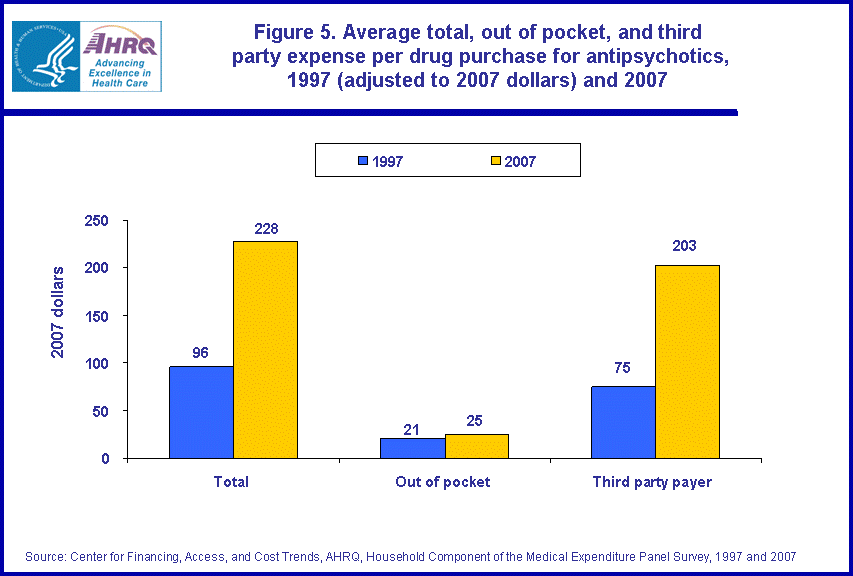 |
||||||||||||||||||||||||
|
||||||||||||||||||||||||
|
|
||||||||||||||||||||||||


